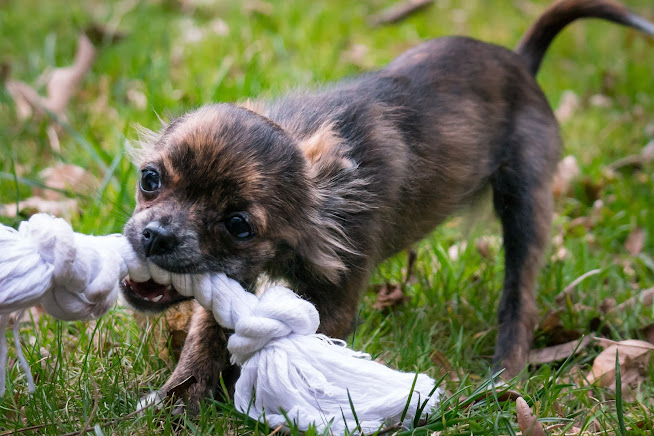How to Get Your Dog to Stop Biting
Any canine can bite. The Centers for Disease Control estimate that 4.5 million individuals are bitten by dogs annually. 1 Although this figure may seem alarming, there are several steps you can take to make sure your dog doesn't add to the statistics on dog bites.
When a dog bites a human, it frequently happens out of fear, protective instinct, or when the dog is ill and wants to be left alone. It takes proper socialization, structure, and confidence-building for your dog to be trained to avoid dog bites.
Make Your Dog Social
The best thing you can do for a new puppy is to expose it to as many new places, people, and circumstances as you can. Positive thinking is key. Socialization is the term used to describe this early encounter.
In unfamiliar situations, a well-socialized puppy is much less likely to be fearful, and this lack of fear reduces the likelihood of aggression. Even if your dog is no longer a puppy, adult socialization can still be worked on.
neuter or spay your dog
There is some evidence to suggest that changed dogs tend to be less aggressive, even if having your dog spayed or neutered does not guarantee it won't bite.
One of the many benefits of having your dog spayed or neutered is the potential reduction in dog bites.
Make no assumptions
Any dog can bite given the correct set of circumstances. Dog bites happen far too frequently to humans because they believe their dog won't harm them. Never assume that a dog won't bite just because it is a particular breed, or size, or has never before displayed aggression.
Improve your obedience training.
A well-behaved dog is simpler to handle. You can use simple commands to keep your dog focused on you while it is uncomfortable by working on your obedience training.
Your dog is less likely to bite you if you have behavior control over it. Training also gives your dog structure and increases its self-assurance.
Use Reward-Based Training
Training a dog using positive reinforcement rewards appropriate behavior rather than punishing bad behavior. Treats, more playtime, verbal praise, petting, and any other activity your dog enjoys can all be used as positive reinforcement.
In contrast, punishment can be anything a dog considers repulsive. Hitting, leash corrections, and physically rolling a dog over, sometimes known as "alpha rolling," are some examples of typical sanctions.
According to a 2009 study, dogs who are trained using punishment are 25% more likely than other dogs to react aggressively. You can lessen the likelihood that your dog will bite by employing positive dog training techniques.
Recognize your body language
Dogs express themselves through body language. Pay attention to what your dog is trying to tell you through his body language. A dog that feels threatened or angry about having its territory invaded may bite.
A dog may be uncomfortable and may bite if its ears are flat against its head, its teeth are exposed, or its hackles are raised.5 If you see a dog exhibiting these behaviors, give it some space and advise others to do the same. As soon as you believe it is safe, remove your dog from the situation.
Never ignore a dog's growls.
When your dog is unhappy with a person or circumstance, it will growl to let you know. It is an indication that it might bite. Our first instinct is frequently to tell our pets that growling is not appropriate.
This lesson may be so effectively retained by the dog that growling will no longer be used. This explains why we frequently hear reports of dogs biting people without cause. We prevent dogs from expressing their discomfort by preventing them from growling.
The best course of action is to pay close attention to the situations that make your dog snarl. Is it growling because someone is getting close to its food dish, a kid is running by, or it is being cornered?
Once you understand the cause of your dog's growling, you can start a training program to help your dog learn to feel more at ease in those circumstances.
By doing this, you address the issue that might otherwise lead to aggression rather than removing your dog's ability to alert you to the possibility of a bite. When your dog feels more secure in a particular circumstance, it won't feel the need to growl.
Issues and Proofing Practice
You must take your dog into unfamiliar surroundings and introduce it to unfamiliar people and animals to verify its new, more suitable behavior. It has assimilated the training if it can sustain its behavior in other contexts; if not, you would need to take further action.
If you are aware of the situations in which your dog is most likely to growl or bite, you should make sure that the dog is capable of handling them without acting aggressively.
While it's not a good idea to surprise or terrify your dog, it can be helpful to gradually introduce difficulties to make sure your dog is capable of handling them.
To ensure that the new behavior is maintained even when a new person enters the room, have another person bring the dog's food if your dog is normally aggressive around food but has learned to behave appropriately during mealtime.
Even if you've used positive reinforcement to train your dog and put a lot of effort into gaining his trust, you might still discover that he struggles to stop growling or biting. You'll need to take extra action if that's the case.
It can be challenging to change your aggressive conduct on your own. You should consult a trained dog trainer or animal behaviorist if you think your dog might turn aggressive or if it has already bitten someone.
To guarantee your and your dog's safety, a professional dog trainer can assist you in developing a strategy to control your dog's aggression.






